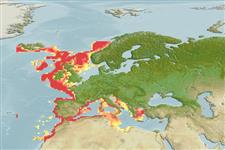Élasmobranches (requins et raies) (sharks and rays) >
Rajiformes (Skates and rays) >
Rajidae (Skates)
Etymology: Leucoraja: Greek, leykos = white + Latin, raja = a fish, Raja sp. (Ref. 45335).
Environment: milieu / climate zone / depth range / distribution range
Écologie
marin démersal; profondeur 10 - 800 m (Ref. 106604). Temperate; 67°N - 27°N, 25°W - 37°E
Eastern Atlantic (Iceland, southern Norway, Skagerrak and Morocco) and the Mediterranean Sea.
Records as far south to Mauritania and Senegal could not be verified due to lacking descriptions and specimens; most are probably misidentifications of Leucoraja leucosticta.
Taille / Poids / Âge
Maturity: Lm ? range ? - ? cm
Max length : 120 cm TL mâle / non sexé; (Ref. 4426); 117.0 cm TL (female); common length : 70.0 cm TL mâle / non sexé; (Ref. 4426)
Épines dorsales (Total) : 0; Épines anales: 0. Snout short, its tip somewhat pronounced; upper surface entirely spinulose, about 8 thorns generally in a complete row around inner margin of eye and a triangle of thorns on nape or shoulder region; underside with prickles only on snout, between gill-slits, along abdomen, and at anterior margins of disc; tail only slightly longer than body; upper surface reddish-brown to dark brown with 4-6 creamy spots on each wing, underside white (Ref. 3167).
Found in offshore shelf waters and on upper slope, mainly around the 100 m line (Ref. 3167). Depth range from 70-275 m (Ref. 03167), and from 463-676 m in eastern Ionian Sea (Ref. 56504). Feed on all kinds of bottom animals (Ref. 3167). Oviparous. Distinct pairing with embrace. Young may tend to follow large objects, such as their mother (Ref. 205). Eggs are oblong capsules with stiff pointed horns at the corners deposited in sandy or muddy flats (Ref. 205). Egg capsules are 8.3-9.2 cm long and 4.6-5.3 cm wide (Ref. 41303, 41251, 41311). Maximum length for female is 117 cm (Ref. 41333).
Life cycle and mating behavior
Maturité | Reproduction | Frai | Œufs | Fécondité | Larves
Oviparous, paired eggs are laid. Embryos feed solely on yolk (Ref. 50449). With no definite egg laying period (Ref. 3167). Distinct pairing with embrace. Young may tend to follow large objects, such as their mother (Ref. 205).
McEachran, J.D. and K.A. Dunn, 1998. Phylogenetic analysis of skates, a morphologically conservative clade of elasmobranchs (Chondrichthyes: Rajidae). Copeia 1998(2):271-290. (Ref. 27314)
Statut dans la liste rouge de l'IUCN (Ref. 130435: Version 2024-2)
Menace pour l'homme
Harmless
Utilisations par l'homme
Pêcheries: intérêt commercial mineur
Outils
Articles particuliers
Télécharger en XML
Sources Internet
Estimates based on models
Preferred temperature (Ref.
123201): 7.5 - 14.2, mean 11.3 °C (based on 116 cells).
Phylogenetic diversity index (Ref.
82804): PD
50 = 0.5000 [Uniqueness, from 0.5 = low to 2.0 = high].
Bayesian length-weight: a=0.00269 (0.00166 - 0.00436), b=3.20 (3.06 - 3.34), in cm total length, based on LWR estimates for this species & Genus-body shape (Ref.
93245).
Niveau trophique (Ref.
69278): 3.5 ±0.37 se; based on food items.
Résilience (Ref.
120179): Faible, temps minimum de doublement de population : 4,5 à 14 années (Fec assumed to be <100).
Fishing Vulnerability (Ref.
59153): High to very high vulnerability (72 of 100).
Climate Vulnerability (Ref.
125649): Moderate to high vulnerability (48 of 100).
Nutrients (Ref.
124155): Calcium = 4.74 [0.63, 82.48] mg/100g; Iron = 0.236 [0.022, 2.817] mg/100g; Protein = 15.9 [13.8, 17.8] %; Omega3 = 0.712 [0.315, 1.677] g/100g; Selenium = 17.7 [3.6, 87.5] μg/100g; VitaminA = 4.71 [0.36, 55.36] μg/100g; Zinc = 0.34 [0.02, 3.76] mg/100g (wet weight);
